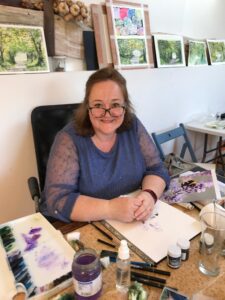
In this article, artist Nicki Saunders shares her techniques for creating a stunning watercolour botanical painting of a delicate rose. Using a simple brush and a thoughtful approach, Nicki guides readers through the step-by-step process.
 I took a photo of this rose on one of our family holidays, when we were ambling along lanes and footpaths. But I simplified the composition of the painting to allow the roses and bee to be the focal point, leaving the leaves to act as a frame.
I took a photo of this rose on one of our family holidays, when we were ambling along lanes and footpaths. But I simplified the composition of the painting to allow the roses and bee to be the focal point, leaving the leaves to act as a frame.
To begin, start by making a light sketch on the Watercolour Paper, carefully capturing the delicate details of the botanical subject. Pay particular attention to the folds and positioning of the petals. Next, prepare a weak wash of Cadmium Yellow Pale and another weak wash of Brilliant Purple on your palette, ensuring you select the perfect hues for your watercolour botanical masterpiece.
When painting each petal, employ the wet-in-wet technique. First, gently wet the petal with clean water (taking care to avoid creating puddles). Then, drop the Cadmium Yellow Pale at the bottom of the petal where it connects to the centre, allowing the color to flow gracefully. Add the brilliant purple to the remainder of the petal. Remember to let each petal dry before proceeding to paint the adjacent ones, preserving the intricate beauty of your composition.
To enhance the washes for the main flower with the bee, consider adding more pigment to intensify the focal points of your artwork. For deeper and richer values, add a touch of Alizarin Crimson to the Brilliant Purple, infusing your masterpiece with captivating depth

After the watercolor flowers dry, add depth and dimension with shadow techniques. Mix French Ultramarine with Brilliant Purple/Alizarin Crimson blend. Apply shadow tones on dry areas and soften with a damp brush. Move to flower centers, noting aging characteristics. Start with the lightest flower on the right. Mix Burnt Sienna with Cadmium Yellow Pale for stamens. Intensify shadows with more Burnt Sienna. Create a light grey shade with French Ultramarine and Burnt Sienna for the bottom flower’s center. Darken stamens with added Burnt Sienna. Paint stamens accordingly.
Before focusing on the main flower, draw the bee. Use a UniPin pen for stripes, head, and legs, leaving white areas for highlights. Use wet-on-dry technique with Cadmium Yellow Pale and Burnt Sienna for bee’s yellow stripes. Combine French Ultramarine and Burnt Sienna for cool light grey wing veins. Apply wet-on-dry mixture of Cadmium Yellow Pale and Alizarin Crimson for the bee’s leg pollen. Add Alizarin Crimson to the right side for a shadow effect. Use Cadmium Yellow Pale for stamens around the bee. Add touches of Quinacridone Gold for shadowed areas. Highlight light stamens on the left with a white UniPOSCA pen. Assess overall form, structure, and definition, adjusting as needed.
For the leaves, use varying mixes of French Ultramarine and Quinacridone Gold, changing the quantities of each pigment and the saturation by altering the water content in each mix. By doing this you can achieve a wide range of colours and values. Include Cadmium Yellow Pale for areas of the leaves that are very yellow, using a wet-in-wet technique. To maintain a level of control, paint the leaves one half at a time using the central vein as a divide. The other half can be added once the initial washes are dry, to prevent them bleeding into each other.
Continue with these colour mixes and techniques to complete all the leaves. Once they’re dry, prop your painting up and step back to view. Again, look for the overall depth of colour, curves of the leaves, values and placement. I left out the leaves around the flower on the right to create a soft, quiet, light space. However, you may feel that you’d like to add some leaves there.
For the background, use French Ultramarine washes and Undersea Green washes, applied wet-in-wet.
This article was originally published in Paint & Create magazine May 2022 edition, with Paint and Create being one of the many perks of SAA Membership.

For more information about Nicki and her work visit nickisaunders.co.uk
Arches Aquarelle Watercolour Paper 140lb Not, soaked and stretched to a SAA drawing board
Schmincke Horadam Artists’ Watercolours: Brilliant Purple
Winsor & Newton Professional Watercolours: Cadmium Yellow Pale, Alizarin Crimson, French Ultramarine, Burnt Sienna, Quinacridone Gold
Daniel Smith Watercolours: Undersea Green
SAA Kolinsky Sable Round, Size 5
Uni-Ball PIN Fineliner Drawing Pen, Black, size 0.5
UniPOSCA White Pin Type PC-1MR size 0.7mm